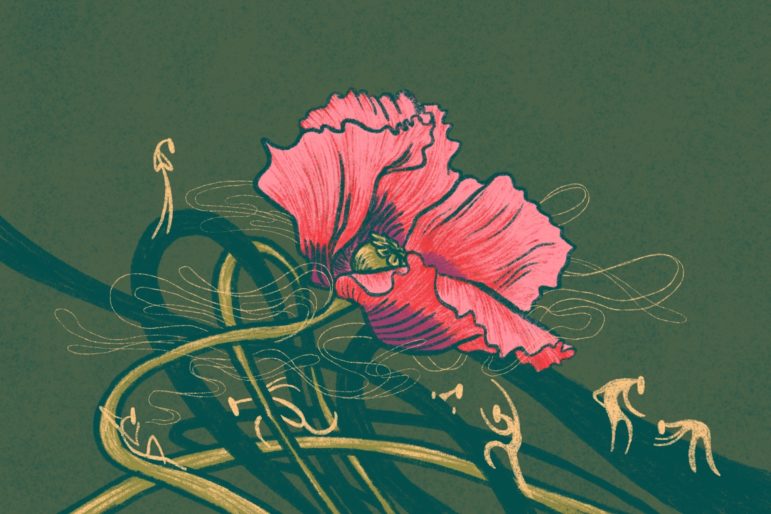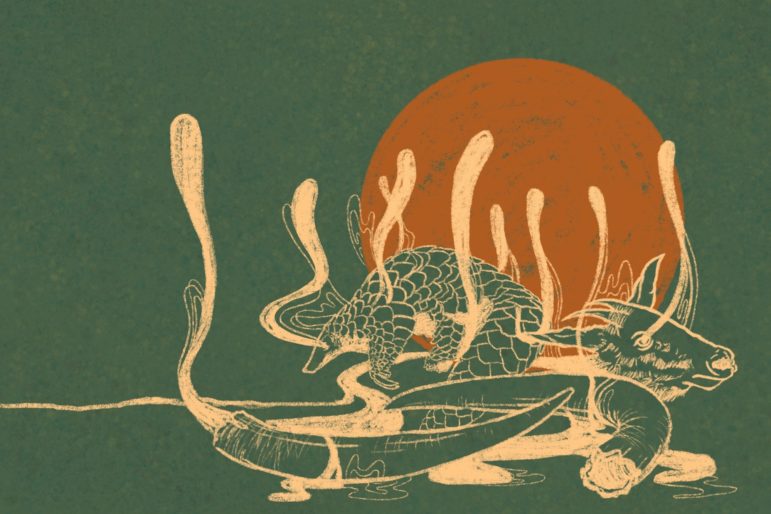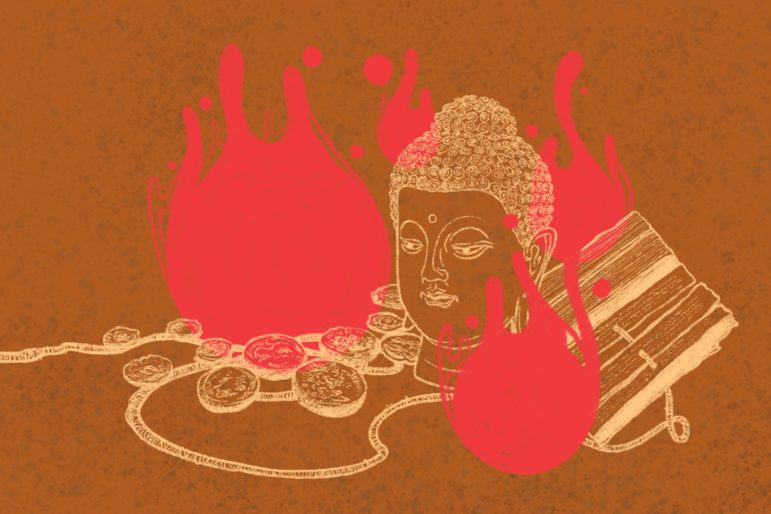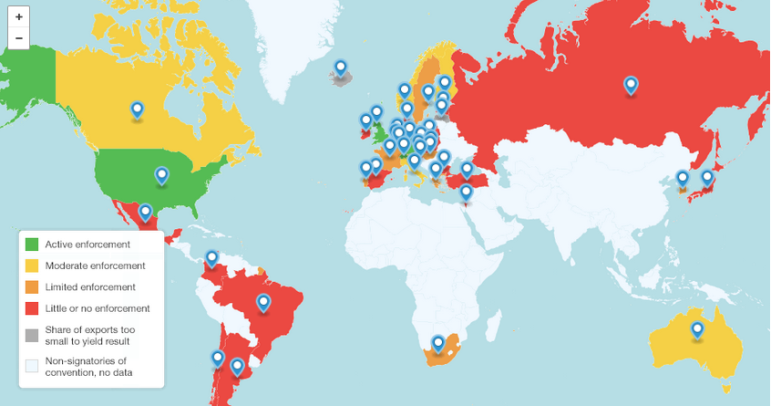

Guide to Investigating Organized Crime in the Golden Triangle: Chapter 4 — Human Trafficking
Chapter Guide Resource
Guide to Investigating Organized Crime in the Golden Triangle — Introduction
Chapter Guide Resource
Guide to Investigating Organized Crime in the Golden Triangle: Chapter 1 — Drug Trafficking
Chapter Guide Resource
Guide to Investigating Organized Crime in the Golden Triangle: Chapter 3 — Money Laundering
Chapter Guide Resource
Guide to Investigating Organized Crime in the Golden Triangle: Chapter 4 — Human Trafficking
Chapter Guide Resource Video
Video: Investigating Organized Crime in the Golden Triangle
Table of Contents | Introduction | Chapter 1 | Chapter 2 | Chapter 3 | Chapter 5 | Chapter 6

Illustration: Nodjadong Boonprasert for GIJN
The networks that smuggle people through the Golden Triangle are essentially the same as those that trade in drugs. The reason is simple: only those gangs know the routes and have the necessary contacts. The first trafficked peoples to flow through this region were Chinese citizens who wanted to go to the United States — the preferred destination — but also to Japan, Taiwan, Australia, or Europe — anywhere that the migrants could attain their dream of a better life. But thanks to rising living standards in China, what was once a flood has become a trickle.
In the next wave were North Koreans, who made the perilous journey through China to Laos and then northern Thailand, where they were processed by Thai and South Korean authorities as seeking political asylum and then allowed to continue to South Korea. They were, in other words, treated differently from other people who had been smuggled through the Golden Triangle. North Koreans are still coming to Thailand, but more controls have made it increasingly difficult to smuggle people across China, and the COVID-19 pandemic has made it much more difficult. Now, in a new wave of migrants, men and women from Myanmar are escaping hardships in their home country and looking for jobs in Thailand. Following the February 2021 military coup in Myanmar, more people from that country are fleeing the junta’s rule and worsening economic conditions.
Trafficking within the Golden Triangle

Many migrants from Myanmar’s Shan State (in red) cross the country’s southern border into northern Thailand to find work. Image: Wikipedia/Creative Commons
Political turmoil, a severe economic crisis, and general underdevelopment in Myanmar have compelled millions of people to flee across the border to Thailand. The International Labor Organization (ILO) stated in a 2019 report that there were 2.9 million registered migrant workers in Thailand, comprising 7.6% of the workforce.
The actual figure, including all those who are not registered, could be at least twice that number. Those in the northern Thai city of Chiang Mai are mostly Shan and have come across the mountains from the Myanmar sector of the Golden Triangle, escorted by gangs that charge a fortune for smuggling people into Thailand. The Shans, Myanmar’s largest ethnic minority group, are closely related to the Thais when it comes to language and culture (the Shans call themselves Tai, the Thais refer to them as Thai Yai), which makes Thailand an attractive destination for many Shans. These migrants from Myanmar dominate the workforce in Chiang Mai’s construction sector, while many Shans work as farm hands or perform other low-wage, menial labor that Thais are reluctant to do. These migrant workers are often cheated out of their salaries and mistreated. The Thai police often apprehend them for minor offenses and then demand bribes. Despite being closely related to the Thais, the Shans also face prejudice from the local population in northern Thailand.
Most Myanmar workers in Thailand are heavily indebted to the gangs that transported them across the border. According to a Deutsche Welle report published in July 2022: “Ten years ago, horrifying reports of extreme debt bondage surfaced from Thailand’s commercial fishing industry, shocking consumers into reconsidering their position on one of Thailand’s leading sectors.” Much of that trade in humans involves criminal gangs that are active in the Golden Triangle.
Apart from being a center for money laundering and drug trafficking, the Golden Triangle Special Economic Zone (GTSEZ), with its Kings Roman casino in Laos, has also become a hub for human trafficking. Many of the victims are young Lao women who have been lured into prostitution, according to a March 2022 report by Radio Free Asia. “Many… women and girls are exploited, abused and victimized by human trafficking,” a member of the Lao Women’s Union of Nomo district told RFA. ‘They’re from poor families, uneducated, unaware of the risk, and sold.”

Taunggyi, the capital and largest city of Myanmar’s Shan State. Political turmoil and economic issues have caused many Shan — Myanmar’s largest ethnic minority — to flee across the border into Thailand. Image: Shutterstock
In the Thai city of Mae Sot, 500 kilometers northwest of Bangkok, thousands of Myanmar workers are employed in local industries. Thousands of Myanmar migrants also work in the fishing industry, which is mainly based in Mahachai near Bangkok. Some migrants in Mae Sot have tried to organize unions, but that is illegal under Thai law (only citizens are allowed to join unions).
Very few Chinese people have been able to travel to Thailand since the COVID-19 pandemic broke out in 2020, but those who came before it belong to a category that differs markedly from what the migrants from Myanmar have to endure. Most were casual visitors but some came to stay, and they have money and are able to buy some kind of Thai ID documents. That was usually done by first staying in one of the old Kuomintang settlements in the Thai sector of the Golden Triangle (Mae Salong, Tam Ngob, Ban Mai Nong Bua, Phatang, and others.)
Being Chinese, they can also, for a fee, be included in the house registration of Chinese families that have lived in Thailand for generations and are now citizens. The next illicit step toward achieving more legitimate status is to upgrade that local ID to a bat prachachon, or citizenship card. This trade is difficult for migrants — and risky to investigate — because it involves local, ethnic Chinese “strongmen” as well as corrupt local Thai officials.
Tips and Tools
General tips on how to cover human trafficking in general can be found in this GIJN story and at GIJN’s Resource Center.
The only way to effectively investigate the trade in humans from Myanmar to Thailand is to go to the towns where the migrants live: Mae Sot, Chiang Mai, Mae Sai, Mae Hong Son, and Samut Sakhon. Local journalists, trade union organizers, and NGOs are the best sources.
For background information to the specific situation in Southeast Asia, there are several internet resources:
- This 2022 US Department of State report includes recommendations to the Laos government to tackle human trafficking, but also analyzes the current state of prosecution, protection, and prevention.
- This report published by the Southeast Asia Research Centre (SEARC) of the City University of Hong Kong assesses the situation of Burmese migrant workers in Mae Sot in Thailand. This paper is housed on the free Online Burma/Myanmar Library, which claims to be the largest single resource of material on Burma and can serve as a great resource to journalists.
- When investigating labor issues in the region, contact local NGOs that are trying to support migrant workers in the region like the MAP Foundation or the international Union Aid Abroad APHEDA.
- A 2020 study of Thailand’s fishing sector by the International Labour Organization found that 14% of those working in fisheries were coerced to work there. Although things are improving, according to the ILO, “nearly three-quarters of workers surveyed in 2019 — both fishing and seafood processing — reported that they found work or were recruited via their family and friends. This shift since 2017 away from registered agents and brokers appears to have reduced recruitment fees, but fishers, in particular, continue to report owing debts to employers for migration costs with attendant reports of wage withholding, deception and coercion.”
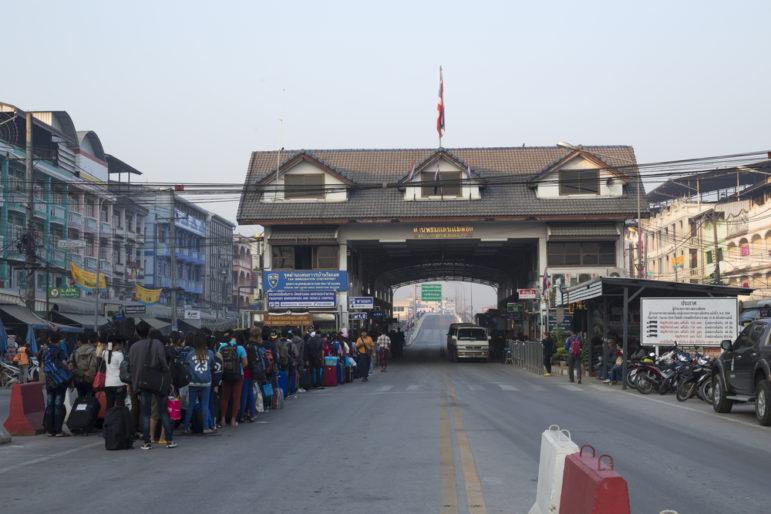
Migrants from Myanmar waiting to cross the border at the Thai-Myanmar Friendship Bridge, which connects the Thai city of Mae Sot to Myawaddy in Myanmar. Thousands of Myanmar workers are employed in local industries in Mae Sot. Image: Shutterstock
Case Studies
There is very little available about recent developments in human trafficking through the Golden Triangle and adjacent areas. One exception is an Al Jazeera story on Myanmar workers trafficked to Thailand, who live in a country that doesn’t recognize them and where they have few labor rights and no right to unionize.
The Diplomat also covered the issue in an August 2022 article. That story includes details of how Chinese-speaking people have been kidnapped and forced to work for criminal gangs in Myanmar. Hundreds of English-speaking Indians and Pakistanis have also been trafficked to Myanmar to run cybercrime operations, including online casinos. According to reports in Indian media, the total number of these trafficking victims is believed to be at least 300.
This piece by Nathan Paul Southern and Lindsey Kennedy on modern slavery in the GTSEZ was published in October 2022, and describes the lives of trafficking victims forced to work in casinos, online scams, and brothels. In a Sydney Morning Herald piece, Southern and Kennedy focus on the online scams from the GTSEZ and explain how “all across South-East Asia, heavily guarded, sinister compounds have sprung up to house these industrial-scale scam operations — and to trap people forced to work for them in terrifying conditions.”
Table of Contents | Introduction | Chapter 1 | Chapter 2 | Chapter 3 | Chapter 5 | Chapter 6
Additional Resources
Reporter’s Guide to Investigating Organized Crime
Human Trafficking Resources: Best Practices in Reporting
10 Case Studies in Human Trafficking
 Bertil Lintner is the author of 22 books on Asian history, politics and crime. He is currently with Asia Times and a former correspondent with the Far Eastern Economic Review, the Swedish daily Svenska Dagbladet, and Jane’s Information Group in the UK. Lintner lives with his family in Chiang Mai, northern Thailand.
Bertil Lintner is the author of 22 books on Asian history, politics and crime. He is currently with Asia Times and a former correspondent with the Far Eastern Economic Review, the Swedish daily Svenska Dagbladet, and Jane’s Information Group in the UK. Lintner lives with his family in Chiang Mai, northern Thailand.


